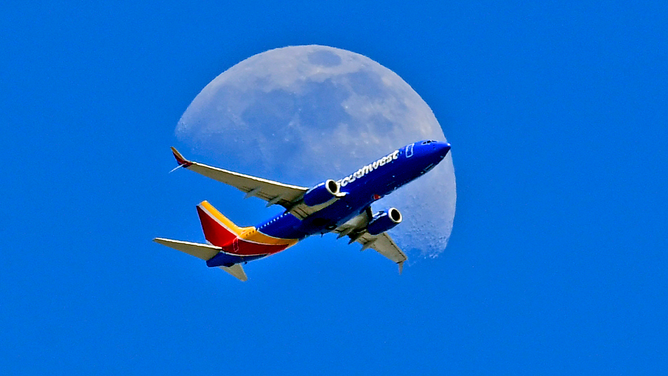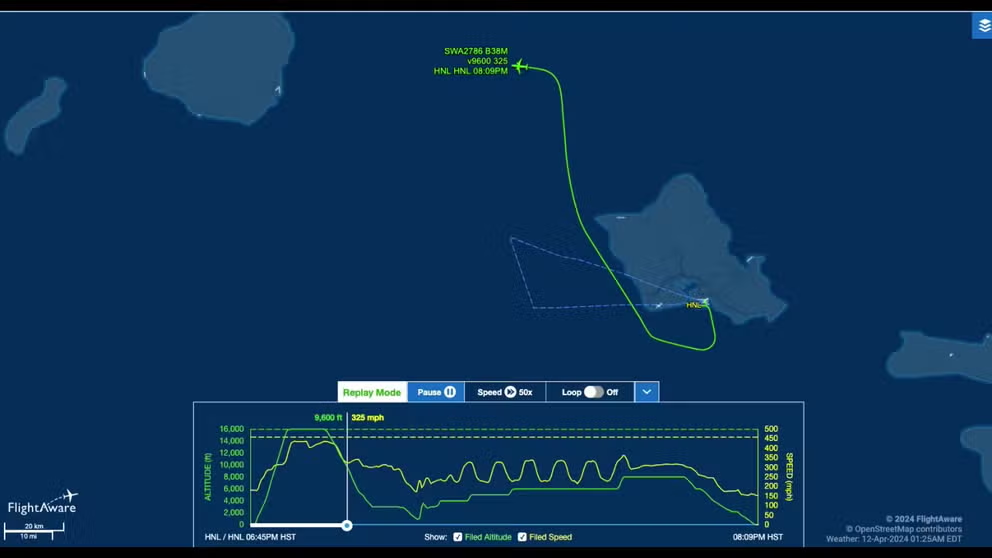FAA investigating Southwest flight in Hawaii that rapidly descended to 400 feet above ocean
"I would think there's a good chance that even in turbulence, passengers would have felt that in their seats," a former pilot says.
Watch: Southwest flight 'inadvertently' made steep descent to 400 feet from ocean
FlightAware mapped out the flight path of Southwest Flight 2786 on April 11. We follow the plane as it takes off from Honolulu and approaches Kauai to land at Lihue. Storms forced the pilots to abandon the landing. According to an internal memo leaked to Bloomberg, the first officer "inadvertently" pushed the control column forward causing the plane to drop down to 400 feet. The graph at the bottom shows speed in yellow and altitude in green. The area where the green line is closest to zero feet in the middle of the chart is the incident and recovery.
The Federal Aviation Administration is investigating an April 11 incident when a Southwest Airlines flight abandoned a landing due to weather and then dropped to just 400 feet above the Pacific Ocean.
During the aborted landing and go-around, the first officer flying the Boeing 737 Max 8 aircraft "inadvertently pushed forward on the control column" and pitched the nose down towards the Earth, according to a Southwest memo sent to pilots about the incident. Bloomberg initially disclosed the leaked memo, and it has since spread across social media.
The plane plunged to almost 400 feet above the ocean before the pilots recovered in an "aggressive climb."
"I would think there's a good chance that even in turbulence, passengers would have felt that in their seats," said former commercial airline pilot and FlightAware spokesperson Kathleen Bangs. "They would have felt the airplane going up and then the drop and then going up again. Hard to know because they know they're low to the ground."
Thunderstorms developed south of destination
Heavy rain triggers flash flooding in Hawaii
Severe storms brought flash flooding to parts of Hawaii overnight into Friday, April 12, causing landslides and leaving people stranded. (Video courtesy: Fern Anuenue Holland via Storyful)
HERE'S WHAT CAUSES TURBULENCE AND WHY YOU SHOULDN'T BE AFRAID OF IT
Flight 2786 took off from Honolulu's Daniel K. Inouye International Airport heading for the Lihue Airport on the island of Kauai at 6:45 p.m. local time, according to FlightAware data. There were thunderstorms developing just south of Lihue when the jet took off and the weather deteriorated through the flight.
The memo also noted that the pilots noticed on radar that several other flights were going around or "performing missed approaches."
Inexperienced first officer flying
The seasoned captain instructed his newer first officer to fly the short trip to gain experience. The first officer had never flown into Lihue before and only observed the captain fly out of Lihue the day before, according to the leaked memo.
The tower advised the first officer that weather conditions were safe for landing, but the pilot ordered a "go-around" because they could not visually see the runway at the minimum altitude, per Southwest and Federal regulations.
According to the memo, the go-around procedure was intensive. The first officer noticed the plane sped up, which it would do on a descent at the same power. They pulled back the throttle. At that point, the plane started diving at around 4,400 feet per minute.
That is more than five times faster than a decent for landing, according to Bangs.
SOUTHWEST FLIGHT MAKES EMERGENCY LANDING IN FLORIDA DUE TO TURBULENCE

File: Southwest Airlines Co. Boeing 737 passenger jets parked on the tarmac at Midway International Airport (MDW) in Chicago, Illinois.
(Photographer: Luke Sharrett/Bloomberg via Getty Images / Getty Images)
"Airlines generally do instrument approaches, and you're following these navigational aids like the glide slope," Bangs said. "And this glide slope helps you even on a perfectly clear day. And you're usually coming in around 7 or 800 feet per minute on the descent."
According to the memo, the first officer told Southwest that they did not hear audible warnings about the plane's proximity to the ground due to the activity in the cockpit.
"The captain assessed that the aircraft was in an undesirable state based on the GPWS (ground proximity warning system) warning and verbalized, ‘Climb’ and ‘Turn Left’ immediately prompting the first officer to increase thrust," said the memo.
The jet then climbed "aggressively" at over 8,500 feet per minute. Eventually, the crew returned to Honolulu.
Bangs said climbs could be anywhere from 3,000 or 4,000 feet to 8,000 feet a minute. Pilots use the sleeper climb if there are noise ordinances or mountains around the airport, like in Aspen, Colorado. Rate of climb is very dependent on temperature and humidity.
No one was injured.
Bangs said at the point of the drop, all passengers should have been wearing seat belts.
Southwest's statement
Bangs said it appears the crew voluntarily reported the incident through the FAA's Aviation Safety Action Program.

FILE - A Southwest Airlines Boeing 737 plane files in front of the moon.
(Nick Ut / Getty Images)
"I would say the captain self reported it," Bangs said. "There is a program with the FAA that's been around for decades now where if pilots encounter something that they feel is a threat to safety, they can self-report it, and then that should minimize any risk of them getting cited for that. So it's to encourage people not to hide safety events, but to actually come forth with them so that not only the FAA can learn, but that other pilots at that carrier and other carriers can also learn from."
In a statement to FOX Weather, Southwest said there's nothing more important to them than safety.
"Through our robust Safety Management System, the event was addressed appropriately as we always strive for continuous improvement," a Southwest spokesperson said in the statement.

